|
XPERT
Gentle giant
Sajitha Prematunge
The total figure of elephants in Sri Lanka
there are around 6000 (10 percent of world elephant population) using
only two percent of the total land area. Protected areas of
Sri Lanka, which adds up to 1.2 million ha, if
perfectly managed, has a carrying capacity of around 1200 elephants

A baby elephant flung upon a tree by the raging flood waters is a
sorry site. Before this it was an elephant, its majestic life taken by
an abandoned well. Stories of gullible baby elephants killed by the
inhumane death trap – Hakka pattas – set by villagers for adult
elephants who destroy their crops and attack humans are often tear
jerking. On top of it only last week another elephant – Neelagiri – died
due to injuries caused by his own mahout.
It is quite unfortunate that after so many centuries of sharing each
other’s space humans and elephants have failed to co-exist. For the most
part this gentle giant has been misunderstood. We – humans – have
encroached on their territory, not vice versa. This is probably due to
lack of understanding of elephant ecology.
The range of animals living in large herds, like elephants, is known
to encompass extensive territories. The home range of a Sri Lankan
elephant is 50 to 100 square km as opposed to 500 to 1000 square km of
Indian elephants. They rarely deviate from their territory, returning to
the same place year after year.
The total figure of elephants in Sri Lanka there are around 6000 (10
percent of world elephant population) using only two percent of the
total land area. Protected areas of Sri Lanka, which adds up to 1.2
million ha, if perfectly managed, has a carrying capacity of around 1200
elephants. So where are all the other elephants? Outside the parks.
People have been generating favourable conditions for elephants for over
1000 years now. Contrary to popular belief Chena provides them food
while the irrigation systems provide them with water they would have
otherwise been forced to find themselves. During the wet season people
cultivate Chenas and during the dry season – when cultivation ceases and
people move out – elephants move in, since there is not enough food for
them within the parks.
|
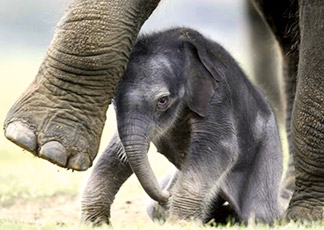
Eliminate distractions when you are sitting down to study |
But the human elephant conflict arises when human territory and
elephant habitats overlap. One of the major reasons for the
human-elephant conflict is unplanned village structures. Fifty percent
of the human-elephant conflicts in Sri Lanka take place in and around
Irudeniyaya an unplanned settlement situated between Thabbowa and
Thahallapallekele.
Unplanned plantations are another instigating factor. Elephants love
sugarcane and the sugarcane fields of Lunugamwehera are an irresistible
attraction for elephants, resulting in repeated confrontations.
If humans suddenly take a fancy to elephants’ ancestral lands,
building roads, villages, cultivating their lands, how can these
creatures be held responsible for the conflicts that are inevitably to
ensue, let alone be punished by such cruel methods.
It is like drawing a line across their migration path and expecting
them not to cross it! As long as we continue to trespass on their
territory no amount of natural barriers or electric fences will put a
stop to this conflict.
Physical features
 Elephants
are the largest land mammals reaching two to 3.6 metres in height and
weighing 3,000 to 5,000 kilograms. Their skin is around three to four centimetres
thick. Elephants
are the largest land mammals reaching two to 3.6 metres in height and
weighing 3,000 to 5,000 kilograms. Their skin is around three to four centimetres
thick.
They eat 10 percent of their body weight each day, which for adults
is between 170 to 200 kilograms. They need 80 to 200 litres of water a
day.
|
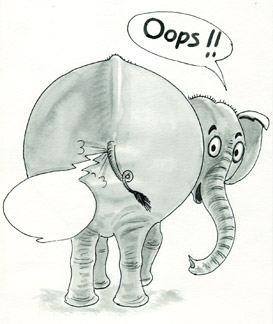
Elefun
Did you know that an elephant emits enough gas per day to
drive a car 20 kilometres! |
The elephant trunk which is actually a fusion of the nose and the
upper lip consists of some 100,000 muscle units, making it very
flexible. It can hold up to 8.5 litres of water.
Elephant society
These usually docile pachyderms are highly intelligent and
self-aware. In fact considering cognitive abilities, latest studies
place them in the same category as great apes. Their closest known
relatives are dugongs, manatees, hyraxes and aardvarks.
They have a matriarchal society, and the group – usually consisting
of 12 to 20 individuals – is led by the oldest female. An elephant’s
life span is 60 years in the wild and 80 in captivity.
The female gives birth to one calf, or occasionally twins. Their
gestation period is 18 to 22 months. At birth, the calf weighs about
100 kilograms and is suckled for up to two to three years. They reach
sexual maturity at nine to 15 years of age.
Number of elephants
* 1800s between 12,000 and 14,000
* 1900s between 10,000 and 12,000
* 1920s – 7,000 and 8,000
* 1970 – 5,000
* 1999 – 4,000
* 2003 – 3,500
* 2004 – 3,350
* 2006 – 3,150
* 2007 – between 2900 to 3000
Caution
During musth the male elephant is highly dangerous. Rogue elephants
and females with calves are to be avoided at all times.
Over short distances they can reach speeds of up to 24 miles per
hour.
Elephant charge with trunk tightly curled up, head held high with
cocked ears.
January 27 Holocaust victims commemoration day:
The Holocaust
Dilmika Tennakoon
“You hear me speak.
But do you hear me feel?”
Written by German, Jewish poet Gertrude Kolmar
who was
murdered in Auschwitz-Birkenau in 1943
The Holocaust began with Hitler’s rise to power in, 1933 and ended
in, 1945. When Hitler’s National Socialist Party seized power, there
were approximately 525,000 Jews living in Germany. Hitler quickly
created a totalitarian state based on racial ideology in theory, in law
and in practice.
Victimization
Most European Jews lived in countries that Nazi Germany would occupy
or influence during World War II. The Holocaust, the genocide was
directed primarily at the Jews of Europe. This developed gradually with
small discriminatory measures, such as university quota limits for Jews,
prohibition of Jewish ownership of German land, deprivation of German
citizenship and legally prohibiting them of a variety of occupations and
rights.
|

Prisoners at Auschwitz |
Laws were redefined expressing what it meant to be a Jew. At the same
time laws were passed making sexual relations between Germans and those
of ‘unacceptable’ race a new crime referred to as ‘Racial Pollution’.
This was punishable by a variety of methods up to death penalty.
Using the tools of science, theorists wrongly claimed that the Jews
and other Middle Eastern ethnic groups and cultures such as the Arabs,
constituted a separate biological category or race. Jews were the most
visible minority in Europe, discribed by many Europeans as a ‘Jewish
problem’.Exclusion
Jews were excluded from society as an ‘inferior race’. The Nazis
believed that Germans were ‘racially superior’ and Jews were a threat.
They strongly believed that they had the moral right to wipe out Jews.
In movies, plays, cartoons and other forms of propaganda, Jews appeared
as rodents, a defective pollutant that must be eliminated from German
society. These illustrations from the Nazi period are evidence of the
fact that scientists and schools teachers used to spread racial
prejudice. The posters “the Jews as bastard” claimed that Jews were not
pure, but came from a mixed breed of inferior races, such as ‘negroes’.
Similar to the experience of blacks in the US, Jews in Nazi Germany
faced segregation laws, physical harassment and limited economic
opportunities that drove them into financial ruin and personal despair.
In every country invaded by Nazis, the Jews were forced to wear badges
marking them.
Pogrom
As a result of a nationwide ethnic cleansing in 1938, nearly 20,000
Jewish men were arrested, brought to concentration camps, tortured and
placed in labour ‘chain gangs’. Some men were castrated, others were
crucified.
Hitler started World War II in 1939. Jews were forced to live in
concentration camps crammed into buildings and shacks with little
sanitation or running water and meagre food supplies. Diseases were
widespread and nearly 5,000,000 people died. Jews were transported to
death camps where they were sorted and classified by the camp physician.
The young and the old were murdered immediately while healthy adults
were worked nearly to death. They were fed less than enough for
survival. Eventually even those who had been strong grew weak and then
were gassed. Millions of Jews and other victims of the Holocaust kept as
forced labourers died from illnesses related to exhaustion and hunger.
As the Nazis expanded their boarders; they killed Jews, mostly in
mass shootings. For those remaining in other parts of Europe, the
Germans constructed six killing centres, such as Treblinka. The primary
purpose of this centre was murdering of Jews with poisonous gas. The
largest of these killing centres and slave labour sites was Auschwitz
Birkenau where an estimated 1.2 million Jews died.
Liberation
The mass murder, which wiped out two-thirds of all European Jews, was
called the ‘Final Solution’ by the Nazis.
During the final months of war, Allied forces moved across Europe in
a series of offenses against Germany. The concentration camp prisoners
were liberated gradually. In 1945 German armed forces surrendered
unconditionally to the Allies. Finally World War II officially ended.
In the aftermath of the Holocaust, many of the survivors found
shelter in displaced persons camps put up by the Allied powers. Between
1948 and 1951, almost 700,000 Jews emigrated to Israel, including
136,000 Jewish displaced persons from Europe. Other Jews emigrated to
the United Sates and other nations.

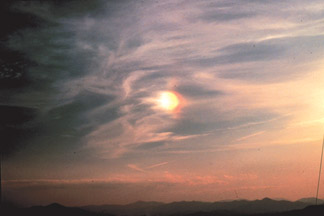 Sundog:
the scientific name for sundog or sun dog is parhelion, from
Greek, which means ‘beside the sun’. This is an atmospheric phenomenon
that creates bright spots close to the sun Sundog:
the scientific name for sundog or sun dog is parhelion, from
Greek, which means ‘beside the sun’. This is an atmospheric phenomenon
that creates bright spots close to the sun
*Stalactite : a mineral deposit of calcium carbonate, in shapes
similar to icicles, that hangs from the roof of a cave

Stalagmite : a cylinder of calcium carbonate projecting upward from
the floor of a limestone cave
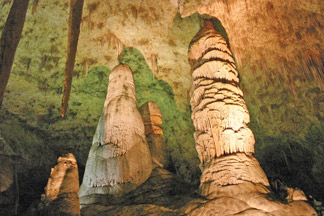
* Onychophagist: person who bites their fingernails
|
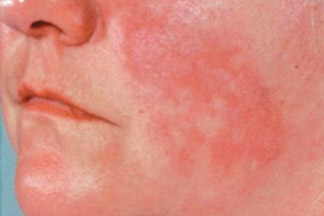
Lesions caused by
photosensitivity |
*Jwalk; walking across a street outside of crossing, against a signal
light
*Arête: a sharp-crested ridge in rugged mountains.
Devil theory : a theory of history which proposes that political and
social crises arise from the deliberate actions of evil or misguided
leaders rather than as a natural result of conditions’
* Photosensitivity: or sun allergy is an abnormally heightened
response, especially of the skin, to sunlight or ultraviolet radiation.
Often caused by certain disorders or chemicals, this condition is
characterized by a toxic or allergic reaction. Some people are sensitive
to sunlight. Photosensitivity may produce a rash, which is known by the
general term, photodermatosis. Itchy eruptions or areas of redness and
inflammation on patches of sun-exposed skin can be observed.
These reactions typically resolve on their own. Patients may not
associate their skin complaint with exposure to light. Very sensitive
patients may even be affected by fluorescent lamps indoors.
|
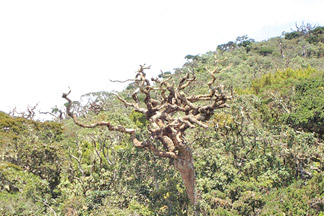
Forest dieback leaves a bare framework of branches |
*Forest dieback: known by many names such as canopy die-back, forest
decline, species level die-back, cohort senescence and stand level
dieback, forest dieback is a condition that has become a major problem
for the forests of countries like North America, Hawaii, Croatia,
Germany, Russia and New Zealand as well as Sri Lanka.
As indicated by the names, when afflicted with this condition forests
lose their vivacity, trees cease growth and leaves discolour and fall
off leaving a bare framework of branches. Other than in Horton Plains
and Haggala, Pidurutalagala ridge, Kobonilgala near Corbet’s gap in
Knuckles have been pronounced as affected by forest dieback.
Explanations range from predisposing factors like other diseases, fog
and damage done to the bark by Sambur and led poisoning.

1905 World’s largest diamond, Cullinan - 3106 carets, found in South
Africa
1915 Alexander Graham Bell in New York calls Thomas Watson in SF
1918 Russia declared a republic of Soviets
1924 1st Winter Olympic games open in Chamonix, France
1955 Columbia U scientists develope an atomic clock accurate to within
one second in 300 years
1961 Walt Disney’s “101 Dalmations” released
1974 Christian Barnard transplants 1st human heart without removal of
old
1980 Paul McCartney is released from Tokyo jail and deported
1980 Dutch Government demands boycott of Olympics
1992 Hubble space telescope optics finds NGC3862/3C264
1994 U.S. space probe Clementine launched
1994 U.S. space probe Clementine launched
2010 One year after thousands of children became ill from melamine in
milk, new traces of melamine in milk products is discovered in China |



